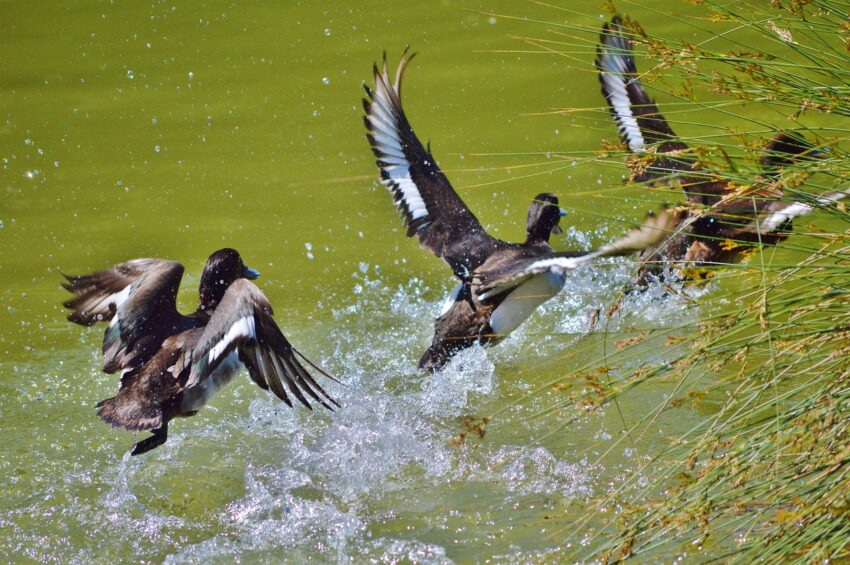North Texas Duck Hunting
North Texas offers a premier destination for seasonal duck hunting. Expansive prairies, wheat fields, and shallow ponds create the perfect conditions for migrating waterfowl. With early morning hunts, changing weather patterns, and strategic field setups, hunters experience a dynamic and rewarding outdoor pursuit.
Daily Hunt Format
Each hunt begins 30 minutes before sunrise and usually wraps up once hunters reach the daily bag limit or around 9:00 a.m. Many choose layout blinds, especially in areas with minimal natural cover. These setups allow ducks to descend directly into decoy spreads, creating close-range opportunities.
As wind and weather shift, hunters adapt their strategies. They reposition blinds, use surrounding brush for concealment, and respond to real-time conditions to stay effective.
Understanding Hunting Conditions and Methods
Success in North Texas duck hunting depends on preparation and flexibility. Hunters often scout the area, study wind direction, and adjust decoys and blinds accordingly. These tactics help increase the chances of attracting flocks and securing clean shots.
Waterfowl Species of North Texas
A wide variety of ducks and geese migrate through North Texas. Bird populations shift throughout the season, so each month brings new species and movement patterns.
Hunters frequently observe:
- Ducks:
Mallards, Northern Pintails, Gadwalls, American Wigeons, Green-winged and Blue-winged Teal, Cinnamon Teal (occasionally), Northern Shovelers, Redheads, Ring-necked Ducks, Canvasbacks, Bluebills, and Wood Ducks (in select areas) - Geese:
Greater and Lesser Canada Geese
Species Guide and Seasonal Timing
Each phase of the migration offers different hunting opportunities. Early in the season, teal and shovelers appear more often. As winter deepens, hunters encounter more mallards, pintails, and canvasbacks. Understanding these patterns helps plan more effective outings.
Hunting Areas and Travel Range
Most hunts take place within North Texas, but bird activity sometimes calls for broader travel. Hunters may travel up to 60 miles to reach optimal conditions. Daily scouting helps identify active zones and avoid unproductive spots.
Scouting and Travel Strategy
Hunters rely on recent sightings, habitat access, and weather conditions to select the best hunting location. By staying mobile and informed, they can increase their odds of encountering large flocks and better shooting scenarios.
Preparation Checklist
Bringing the right gear ensures safety, comfort, and legal compliance. Each hunter should prepare thoroughly before entering the field.
- Firearms and Ammunition:
Use a 12- or 20-gauge shotgun with steel shot only (#2 or #4 recommended). Most prefer 3” shells, although 2.75” shells are acceptable. Avoid lead shot, as it is not allowed. - Clothing and Protection:
Wear layered camouflage clothing to stay warm. Chest waders or waterproof boots keep feet dry. Gloves, face coverings, ear protection, and hand warmers are also essential. - Additional Essentials:
Pack a waterproof camouflage jacket, wide-brimmed hat, headlamp or flashlight, snacks, water, and a signed release form. A camera or video recorder is optional for documenting the experience.
Full Gear Checklist and Field Tips
Always inspect your gear before the hunt. Charge flashlights, organize ammunition, and test equipment in advance. Dressing in layers helps manage fluctuating temperatures, especially during cold mornings.
Licensing and Legal Requirements
Before heading out, hunters must meet state and federal legal requirements. These rules support responsible and ethical hunting.
- Hunter Education:
All hunters must complete the required certification. - Licensing:
Secure a valid Texas hunting license, federal duck stamp, and any applicable state endorsements. - Species Identification:
Each hunter must recognize different species and understand daily bag limits to avoid violations.
Hunting Laws and Education Overview
Stay informed about local regulations, shooting hours, and zone-specific restrictions. These guidelines protect wildlife and maintain hunting opportunities for future seasons.
